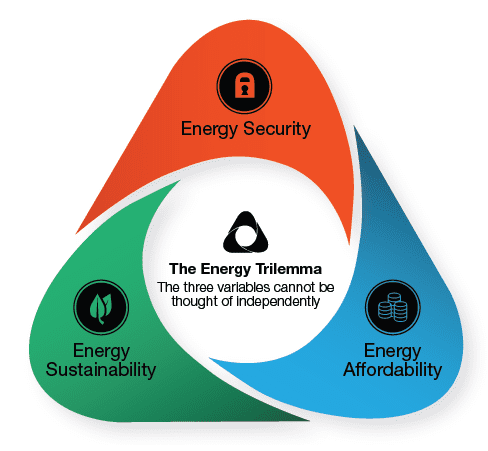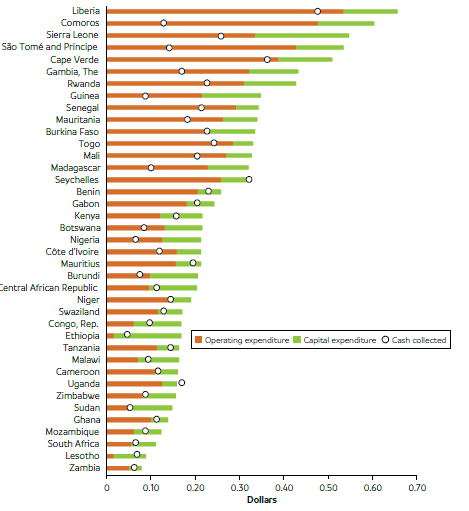Energy Trilemma: A Case for Africa Power Utilities

A trilemma is a situation that presents three possible choices to a complex challenge. Due to mutual exclusivity of the available choices, achieving them simultaneously is always a daunting task. The overarching objective is to achieve the three possible solutions in a balanced manner.
Energy trilemma refers to the need to find a balance between reliability, affordability, and sustainability for a given country, utility, or power pool as illustrated in Figure 1. Very reliable energy is not of much use if it is very expensive. On the other hand, affordable energy is not good for an economy if it is rarely available or is generated and transmitted in ways that destroy the environment.
 1. Energy trilemma. Source: Mutegi Mbae
1. Energy trilemma. Source: Mutegi MbaeAfrica is a rich continent in terms of energy resource availability, which is estimated at: solar (10 TW), hydro (350 GW), wind (110 GW), and geothermal (15 GW). Each country has unique and complex energy resources, opportunities, and challenges that play differently toward achieving a balanced energy trilemma.
World Energy Trilemma Index 2022The World Energy Trilemma Index (as developed by the World Energy Council) ranks 127 countries on their ability to balance the three energy trilemma aspects. The key challenge of the energy trilemma has been how to improve reliability, affordability, and sustainability aspects of energy in a balanced manner.
The index provides a good platform to celebrate and learn from best practices from across the globe in an era of major energy challenges across the world. The report highlights a country's ability to meet its current and projected clean power demand sustainably, at best prices, whilst withstanding any shocks with minimal system disruptions.
The need for a multi-sectoral approach toward balancing the delicate energy trilemma has never been more important. Policymakers, sector players, regulators, and government's roles remain of critical importance.
The top countries in the index remain largely unchanged due to their well-established energy policies and diverse energy systems. Sweden, Denmark, and Switzerland, respectively, lead the global pack and are doing very well in all of the three trilemma dimensions. All have done very well in the areas of energy policies toward rapid decarbonization, energy security, access and equity, environmental sustainability, variable renewable energy generation coupled with robust grid integration, low share of natural gas in the energy mix, diversified energy systems, storage, and energy affordability.
In Africa, Kenya (#100) and Ethiopia (#94) were listed among the 10 most-improved countries in the overall index. In terms of access to affordable energy, Ethiopia, Kenya, Nigeria, and Tanzania were listed among the overall top 10 most improved. All the four achieved a score of D for energy equity, showing that there is big room for improvement. Overall, Zimbabwe, Mozambique, Malawi, Chad, Democratic Republic of the Congo, Benin, and Niger sit at the bottom of the 127 countries surveyed. This is for all the three aspects of energy trilemma.
Only 39% of the continent's population has access to electric energy as compared to 70% to 90% in other developing countries. Africa lags behind all other regions of the world in terms of power generation capacity-a total of less than 100 GW-and per capita energy consumption.
Africa Power UtilitiesMany African power utilities have long been in difficult positions both operationally and financially. They are expected to maintain dependable power supplies, vide a cheap tariff, whilst taking care of environmental concerns in an era of evolving climate change challenges. The agenda of 3Ds-digitization, decentralization, and decarbonization-for energy squarely feeds into the delicate energy trilemma balance.
A number of African power utilities have been working on opening up the sector, whereas, generation, distribution, and retail are open to competition, with transmission and some distribution aspects remaining within state control. The objectives of this have been to attract investment, improve efficiency, and tariff reduction. Countries like Rwanda, Kenya, and Tanzania have liberalized their energy sectors with mixed success. About 30% of all African utilities are still run as vertical entities. Low per capita energy consumption and ageing grid components have slowed the expected gains.
The objective of growing cross-border energy trade has been slow because of poor regulation, low levels of investment, and other barriers to trade. The South African Power Pool is the most advanced. Planned upgrades to the East African and West African power pools have been slow. We can learn many lessons from Nordic and European power pools in this regard.
Big economies within the continent, such as Nigeria and South Africa, are still experiencing serious power rationing largely due to lack of generation, frail transmission and distribution networks, and crippling power utility debt. South Africa is in the process of unbundling Eskom to three utilities to handle generation, transmission, and distribution. This is expected to shore up the generation shortfall (that stands at more than 20 GW) by attracting more players into the generation space.
Universal access to reliable, cost-effective, and clean energy is still a rolling challenge in Africa. The continent has about 500 million people who have no access to clean and cheap power as one of the key ingredients toward economic growth. Decentralized generation and distribution, using sources such as wind and solar, will enable the continent to move faster in this area. This will go a long way in advancing the third leg of the energy trilemma-environmental sustainability. As per the International Energy Agency's 2020 report, solar power is the cheapest source of electric power, followed closely by wind, thus the affordability aspect will be taken care of.
Current SituationA 2017 World Bank study titled Making Power Affordable for Africa and Viable for Its Utilities'' shows that many power utilities in Africa are struggling on major fronts of financial viability and universal access to clean, reliable, and affordable power. A total of 39 utilities were looked at in the study. Only power utilities in Seychelles and Uganda were fully able to cater for their operational and capital costs from their cash collection. Utilities in 19 countries were only able to cater for their operational costs from their cash collection. Figure 2 below illustrates a comparison of the electric power supply costs (in U.S. dollars) with cash collected per kWh billed for various power utilities across Africa.
 2. Electric power supply costs against cash flow for Africa power utilities. Source: World Bank Making Power Affordable for Africa and Viable for Its Utilities''
2. Electric power supply costs against cash flow for Africa power utilities. Source: World Bank Making Power Affordable for Africa and Viable for Its Utilities''Key highlights of the study include, but are not limited to, the need to reduce commercial and technical losses to a maximum of 10% of the transmitted energy, controlled tariff hikes to bridge cashflow shortfalls for activities such as grid maintenance and upgrade, prepaid metering for all low-income households for better and cheaper collection, and affordable initial connection cost.
On average, power utilities in the continent lose an average of 23% (as compared to the global average of 10%) of all energy generated largely due to operational inefficiencies-estimated at $3.3 billion per year. Cutting technical and commercial losses to below 10% could see an additional 11 countries take care of their financial shortfalls. In the face of rising power demand, commercial and technical loss reduction alone may not help in elimination of outages in many countries. Capital investments for such utilities running large cash deficits are a big challenge. The high risk of investing in such utilities makes the cost of capital very high.
Considerably high power tariffs continue to push middle to large manufacturers to cheaper alternative sources, such as solar, further denting power demand for the already strained utilities. All of the top 10 African countries with the highest unit costs depend on oil-fueled generation with the exception of Guinea and Sierra Leone.
A 2018 study by Clarion Energy and the Gordon Institute of Business Science (University of Pretoria) titled The future of power utilities in Africa" further underpins the above findings. The report reiterates the importance of good governance and better cashflow to improve Africa power utilities viability.
Much to Be DoneAfrica has some of the fastest growing economies in the world. Access to clean, affordable, and reliable electric power is a key ingredient for faster economic growth and development of any economy.
African countries have a long way to go in terms of improvement in the energy trilemma index. We have many valuable lessons and best practices that we can learn from the best-performing countries, utilities, and regional power blocks. The potential is huge, all is not lost, but a lot needs to be done by all players across board.
-Dr-Eng. Mutegi Mbae is the acting regional manager for Nairobi with Kenya Power.
The post Energy Trilemma: A Case for Africa Power Utilities appeared first on POWER Magazine.